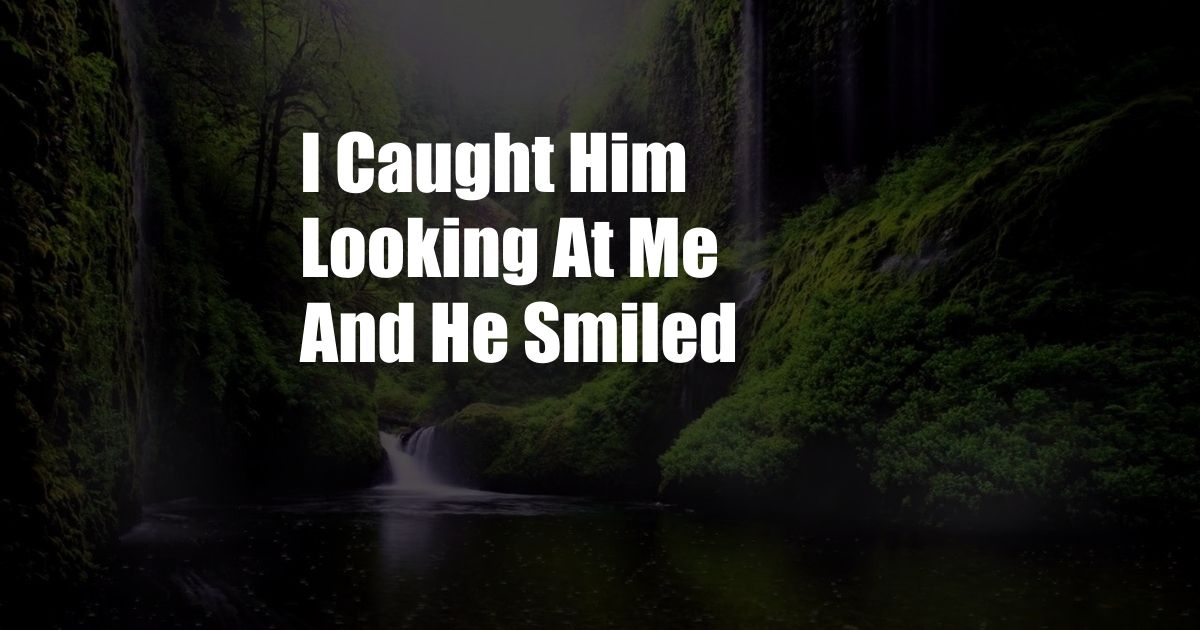
I Caught Him Looking at Me, and He Smiled: Unraveling the Mystery Behind His Gaze
In the bustling corridors of a crowded office building, amidst the endless chatter and hurried footsteps, my eyes met his. He was standing a few feet away, immersed in his work. As I looked up, our gazes locked, and a faint smile played across his lips. In that fleeting moment, a surge of emotions washed over me, a mix of curiosity and trepidation.
The encounter was brief, yet it lingered in my mind. What did his smile signify? Was it a mere acknowledgment, a friendly gesture, or something more? I couldn’t shake the feeling that there was a deeper meaning behind his seemingly casual glance.
Eye Contact: A Window to the Soul
From time immemorial, eye contact has been recognized as a powerful form of nonverbal communication. It can convey a wide range of emotions, from attraction to hostility, from interest to disinterest. When two people lock eyes, a connection is established, a bridge that allows them to communicate beyond words.
Psychologists have studied the phenomenon of eye contact extensively, revealing its profound impact on human interaction. Research indicates that prolonged eye contact can increase feelings of intimacy and trust, while avoiding eye contact can signal disengagement or discomfort.
Smiling: A Complex Social Behavior
Smiling is another complex aspect of human behavior that has captivated scientists for centuries. A smile can serve a variety of purposes, including expressing happiness, showing friendliness, indicating submission, or even concealing emotions.
The meaning of a smile is often influenced by cultural context and individual circumstances. In Western cultures, a smile is generally interpreted as a sign of positive emotions, while in other cultures, it may have different connotations.
Eye Contact and Smiling: A Dynamic Duo
When eye contact is combined with a smile, the result can be an even more potent form of communication. This dynamic duo can convey a multitude of messages, from flirtation to invitation, from approval to reassurance.
In the context of romantic relationships, eye contact and smiling can play a crucial role in establishing and maintaining intimacy. They can signal interest, attraction, and a desire for connection. However, it’s important to note that the interpretation of these nonverbal cues can vary depending on the individuals involved and the specific situation.
The Interpretation Challenge
While eye contact and smiling can provide valuable insights into human behavior, it’s essential to approach the interpretation of these nonverbal cues with caution. There is no one-size-fits-all formula, and the meaning of these gestures can be influenced by a variety of factors, including cultural context, individual differences, and the overall circumstances.
When attempting to decipher the meaning behind a particular eye contact and smile, it’s helpful to consider the following:
- The duration and intensity of the eye contact
- The context in which the interaction occurs
- The relationship between the individuals involved
- Any other nonverbal cues that may provide additional information
Tips for Navigating Eye Contact and Smiling
Navigating eye contact and smiling can be a subtle art. Here are a few tips to help you navigate these nonverbal cues effectively:
- Pay attention to your own eye contact behavior. Are you making eye contact in a way that is authentic and respectful?
- Be aware of your smile. Is your smile genuine and appropriate for the situation?
- Consider the cultural context. Be mindful of the nonverbal norms of the culture you are in.
- Trust your intuition. If you feel uncomfortable with someone’s eye contact or smile, it’s okay to adjust or disengage.
Conclusion
The beauty of eye contact and smiling lies in their power to communicate a myriad of emotions and intentions. By understanding the underlying dynamics of these nonverbal cues, we can enhance our interpersonal relationships and foster deeper connections with others.
As you navigate your own social interactions, remember that eye contact and smiling are powerful tools that can be used to express yourself, connect with others, and build stronger bonds.
Now, I ask you, dear reader, are you ready to decode the secrets of the human gaze? Are you prepared to use eye contact and smiling to your advantage, creating meaningful and memorable interactions with those around you?
| Question | Answer |
|---|---|
| What does eye contact generally indicate? | Eye contact can convey a wide range of emotions, from attraction to hostility, from interest to disinterest. |
| What does a smile usually signify in Western cultures? | In Western cultures, a smile is generally interpreted as a sign of positive emotions. |
| How does cultural context influence the interpretation of eye contact and smiling? | The meaning of eye contact and smiling can vary depending on cultural norms. |
| What are some factors to consider when interpreting eye contact and smiling? | Factors to consider include duration, intensity, context, relationship, and other nonverbal cues. |
| What are some tips for navigating eye contact and smiling effectively? | Pay attention to your own behavior, consider the cultural context, be aware of your smile, and trust your intuition. |